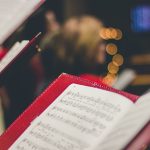Reach for the Moon with The Girl with the Numbers by Marie-Claire Saindon
The Girl with the Numbers by Marie-Claire Saindon shares the story of American mathematician Katherine Johnson, known most prominently for her work calculating rocket trajectories for NASA’s first orbital flight with Friendship 7 and the first human flight to the moon with Apollo 11.
Highlighting Johnson’s love of numbers and featuring her mantra “I am no better than anyone, but no one is better than me,” Saindon poignantly reflects on the life and work of the mathematician with soaring melodies and dancing harmonies throughout. Below, I discuss the following aspects of The Girl with the Numbers by Marie-Claire Saindon:
- Featured Composer: Marie-Claire Saindon
- The Main Character: Katherine Johnson
- NASA, the Space Race, and The Civil Rights Movement
- Musical Numbers in The Girl with the Numbers
Are you teaching The Girl with the Numbers by Marie-Claire Saindon to your ensemble or want your group to get to know the piece in addition to their repertoire? Don’t forget to take a look at my The Girl with the Numbers Teaching Resources!

“Can a ‘Computer in Skirts’ Change the Script?”
This past summer, I interviewed composer Marie-Caire Saindon about The Girl with the Numbers for the Inspired Choir Summer Summit. Pretty quickly, I knew that this piece belonged on our Treble Ensemble’s Fall Concert. Last year, Scarlet Voices performed Saindon’s three part work Méditations de la Vierge Marie and we were obsessed with her skill for writing for treble voices, so I was eager to program yet another one of her works this year.
The Girl with the Numbers by Marie-Claire Saindon has not disappointed. Our singers have gushed about the harmonies, stories, and message behind this work. Read on to learn about composer Marie-Claire Saindon, mathematician Katherine Johnson, NASA, the Space Race, and The Civil Rights Movement, and the role of numbers in music.
Featured Composer: Marie-Claire Saindon
Marie Claire Saindon is an award-winning composer based in Montréal, Canada who is known for her choral work as well as her film scoring. Since her start in high school, Saindon has enjoyed a variety of musical collaborations including everything from writing and producing a musical to scoring short films to fiddling with a team of folk musicians.
As the composer in residence for Choeur Adleisia, an advanced, bilingual, upper-voice chamber choir based in Montreal, Canada, Saindon has written quite a few choral works that feature treble voices. Some of these pieces include:
Check out Marie Claire Saindon’s website here for more information about her, her work, and upcoming events.
The Main Character: Katherine Johnson
Our first concert of the year features choral works that feature a “main character.” The main character of The Girl With the Numbers by Marie-Claire Saindon is American mathematician, Katherine Johnson. Working for the National Aeronautics and Space Administration (NASA) from 1953 to 1986, Katherine was instrumental in calculating trajectories, launch windows, and critical re-entry paths for early space missions, including those of John Glenn and Alan Shepard.
Johnson’s work was crucial to the success of NASA’s Apollo Moon landing program, as well as the Space Shuttle program. In 2015, she was awarded the Presidential Medal of Freedom by President Barack Obama for her contributions to space exploration. Johnson’s story was also popularized in the 2016 film “Hidden Figures,” which chronicled the work of several African-American women at NASA during the Space Race.
Composer Marie-Claire Saindon shares in her detailed program notes that The Girl with the Numbers is her reaction to Katherine Johnson’s autobiography written for young adults, Reaching for the Moon. Learn more about the main character by checking out an excerpt of the inspirational autobiography here.

NASA, the Space Race, and The Civil Rights Movement
During the 1960s, NASA was at the forefront of the American space race. However, the organization was not immune to the social and political movements of the time, including the Civil Rights Movement.
At the time, NASA was largely segregated, with African American employees facing discrimination and limited opportunities. As Richard Paul of the Smithsonian Magazine explained it, African-Americans in the space program “performed mathematical and engineering work at a time when laws would not allow them to use the same bathroom as their white co-workers.”
Pressure from civil rights leaders and activists helped to spark change within the organization in the early 1960s. NASA began to integrate its workforce, hiring more African American employees and promoting diversity and inclusion. This shift helped to pave the way for greater representation of minoritized groups within the organization.
Katherine Johnsons began her role at NASA prior to these 1960s changes. As an African American woman, she faced discrimination and segregation in both her personal and professional life. Her exceptional skills led to her being one of the few Black women to work as a “human computer” at NASA.
Johnson’s calculations were critical to the success of the first manned spaceflight by an American, and her work paved the way for future generations of women and minorities in STEM fields. As Johnson stated in an interview with NASA, “We will always have STEM with us. Some things will drop out of the public eye and will go away, but there will always be science, engineering, and technology. And there will always, always be mathematics.”

The Role of Numbers in Music
Take a glance at or listen to The Girl with the Numbers and you will notice that the majority of the words sung are numbers. In an interview with me this past summer, composer Marie-Claire Saindon said that one of the things that attracted her to Katherine Johnson’s life is that “she was just in love with numbers; absolutely in love.” Recalling a quote from Johnson’s autobiography about how she always had numbers in her head, Saindon found a connection to the mathematician: as a composer, she always has music in her head.
Throughout the harmonies within The Girl with the Numbers, the composer used scale degree numbers instead of words. In music theory, scale degree numbers are used to describe the position of individual notes within a musical scale. These numbers are assigned to each note in the scale, starting with the tonic note as scale degree 1 and proceeding upwards through the other notes in the scale. (For those who use Solfege as a learning tool: Do = 1, Re = 2, Mi = 3, and so on).
Scale degree numbers can be a useful tool for musicians and composers to analyze and understand the relationships between notes in a given key. (For example, the interval between scale degrees 1 and 5 is known as the perfect fifth and is a common interval used in many musical styles.) Inspired by the quote from Johnson’s autobiography, “Numbers loved me. They followed me everywhere,” Saindon decided to use “dancing numbers” throughout the composition.
Complementary Pieces
Want to listen to other pieces like The Girl with the Numbers? Or planning a concert and need some programming ideas? Here are a few complementary pieces!
Here are some Songs about Women by Women:
- What Happens When A Woman by Alexandra Osavsky
- Say Her Name by Alysia Lee
- Lineage by Andrea Ramsey
- Quilt Songs: Women Weaving the Fabric of Life: A larger work with pieces by Alice Parker, Libby Larsen, Gabriela Lena Frank, Ysaye Barnwell, and Carol Barnett
Other repertoire I’ve programmed with The Girl with the Numbers by Marie-Claire Saindon this “Main Character Energy” themed concert cycle:
- Though Philomela Lost her Love by Thomas Morley
- Marie Madeleine arr. Jeanette Gallant
- Hébé by Ernest Chausson arr. Mari Esabel Valverde
- Sing, Wearing the Sky by Jake Runestad

I’d Love to Hear from You!
Have you sung or conducted The Girl with the Numbers by Marie-Claire Saindon with your choir? What conversations did you have as you prepared the piece? How did you feature Katherine Johnson’s story? Share your challenges and triumphs with this piece in the comments below!
The Girl with the Numbers Teacher Resources!
FREE The Girl with the Numbers Reading Comprehension Worksheet
Reading Comprehension Worksheets pull five key points from the blog post above. Additionally, they ask singers to consider musical decisions they can make with the info from this post. Fill in the form below and get a link to a folder including the The Girl with the Numbers worksheet.
Inspired Choir Interview with the Composer
For more information on The Girl with the Numbers straight from the composer, as well as 24 other interviews with 22 composers, check out the Inspired Choir Summer Summit All-Access Pass. The all-access pass includes:
- 25 Video Interviews – All Close Captioned
- A PDF download of all the summit interview transcripts,
- Classroom comprehension worksheets for all summit interviews.
Looking for a Teaching Guide or Lesson Plan Bundle for The Girl with the Numbers? Let me know at hello@inspiredchoir.com!









